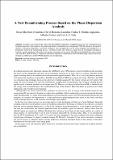Por favor, use este identificador para citar o enlazar a este item:
http://hdl.handle.net/10261/44699COMPARTIR / EXPORTAR:
 SHARE
BASE SHARE
BASE
|
|
| Visualizar otros formatos: MARC | Dublin Core | RDF | ORE | MODS | METS | DIDL | DATACITE | |

| Campo DC | Valor | Lengua/Idioma |
|---|---|---|
| dc.contributor.author | Martínez-Graullera, Óscar | - |
| dc.contributor.author | Romero-Laorden, David | - |
| dc.contributor.author | Martín Arguedas, Carlos J. | - |
| dc.contributor.author | Ibáñez Rodríguez, Alberto | - |
| dc.contributor.author | Gómez-Ullate Alvear, Luis | - |
| dc.date.accessioned | 2012-01-25T11:05:40Z | - |
| dc.date.available | 2012-01-25T11:05:40Z | - |
| dc.date.issued | 2012-01-25 | - |
| dc.identifier.uri | http://hdl.handle.net/10261/44699 | - |
| dc.description.abstract | To improve the results of the Delay-And-Sum (DAS) beamformer a weighting factor based on a measurement of the phase dispersion of the signals in the image point under consideration has been proposed. With this objective, the spectral analysis of the phase dispersion is used here to obtain a new descriptor that can be easily computed and introduced as a ponderation factor in the beamforming process. Theoretical results show that, for a linear array of 32 elements operating in synthetic aperture technique with dynamic focussing in emission and reception (Total Focussing Method) the improvement can reach up to 24dB. In order to validate the theoretical hypothesis, experimental results obtained using a linear array of 64 elements (2,4MHz) and a CIRS 040GSE phantom also are presented. | es_ES |
| dc.description.sponsorship | This work has been supported by the Spanish Ministry of Science and Innovation under the project DPI2010-19376 | es_ES |
| dc.language.iso | eng | es_ES |
| dc.rights | openAccess | es_ES |
| dc.subject | ultrasonic imaging | es_ES |
| dc.subject | Beamforming | es_ES |
| dc.subject | SAFT | es_ES |
| dc.subject | GEUS | - |
| dc.title | A New Beamforming Process Based on the Phase Dispersion Analysis | es_ES |
| dc.type | comunicación de congreso | es_ES |
| dc.description.peerreviewed | Peer reviewed | es_ES |
| dc.relation.isrelatedtoRevision | http://digital.csic.es/handle/10261/131503 | * |
| oprm.item.hasRevision | yes ok 1 true | * |
| dc.type.coar | http://purl.org/coar/resource_type/c_5794 | es_ES |
| item.fulltext | With Fulltext | - |
| item.languageiso639-1 | en | - |
| item.openairecristype | http://purl.org/coar/resource_type/c_18cf | - |
| item.openairetype | comunicación de congreso | - |
| item.cerifentitytype | Publications | - |
| item.grantfulltext | open | - |
| Aparece en las colecciones: | (CAEND) Comunicaciones congresos | |
Ficheros en este ítem:
| Fichero | Descripción | Tamaño | Formato | |
|---|---|---|---|---|
| A_new_beamfroming_process_based_on_the_phase_dispersion_analysis.pdf | 643,77 kB | Adobe PDF |  Visualizar/Abrir |
CORE Recommender

La reputación del trabajo revisado es el promedio de las calificaciones de sus revisiones. Se necesitan al menos 2 revisiones, o la reputación del trabajo estará sin definir. Además, la reputación depende de la reputación de los revisores, que se obtiene de los comentarios que pueden hacer los autores sobre las revisiones recibidas. Cada vez que un trabajo recibe una nueva revisión o cada vez que una revisión recibe un nuevo comentario de autor, la reputación del trabajo revisado se recalcula. Más en Preguntas frecuentes.
Page view(s)
349
checked on 24-abr-2024
Download(s)
330
checked on 24-abr-2024
Google ScholarTM
Check
NOTA: Los ítems de Digital.CSIC están protegidos por copyright, con todos los derechos reservados, a menos que se indique lo contrario.
